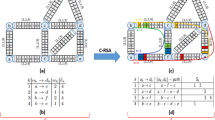Abstract
The problem of assigning single paths to point to point demands in a network arises in the telecommunications industry. The well known atm technology involves such a problem when each demand must be assigned to a single virtual channel in an atm backbone network. This problem is referred to as the Bandwidth Packing Problem. For a given network and a set of point to point demands with related bandwidth requirement and profit, the problem consists in determining the most rewarding subset of demands for which all demands are single path routed according to the link capacity constraints. We propose a heuristic derived from an exact method to solve this problem. We use cutting planes to strengthen a path-based linear relaxation embedded in a Branch&Cut scheme. The results particularly depend on the ratio of the average edge capacity to the average bandwidth required by the demands. The method provides optimum or nearly optimum solutions for practical telecommunications problems within small computational time.
Résumé
Le problème de monoroutage dans un réseau de télécommunication consiste à router chaque demande point à point sur un unique chemin. Ce problème apparaît avec la technologie de transport atm qui affecte à chaque demande un canal virtuel vc. Ce problème est connu sous le nom de Bandwidth Packing Problem. Étant donné un réseau et un ensemble de demandes point à point caractérisées par un débit et un profit, il s’agit de sélectionner un sous-ensemble de demandes qui maximise le profit total, et dont chaque demande est associée à un unique chemin en cohérence avec la capacité du réseau. Une heuristique inspirée ďune méthode exacte est proposée. Il s’agit ďune relaxation linéaire en formulation chemins, renforcée par des coupes polyédriques et qui est utilisée au sein ďun schéma de Branch&Cut. Les résultats dépendent en particulier du rapport de la capacité moyenne des arêtes au débit moyen des demandes. Ľalgorithme fournit en peu de temps des solutions optimales ou quasi optimales pour des réseaux de télécommunication opérationnels.
Similar content being viewed by others
References
Ahuja (R.K.), Magnanti (T.L.), andOrlin (J.B.), Network Flows: Theory, Algorithm, and Applications,Prentice Hall, Englewood Cliffs, NJ, 1993.
Barnhart, (C.),Hane (C.A.),Johnson (E.L.),Sigismoncli (G.), A column generation and partitioning approach for multicommodity flow problems,Telecommunication Systems 3 pp. 329–358, 1995a.
Ben-Ameur (W.),Liau (B.),Gourdin. (W.E.), Internet routing and topology issues submitted to Networks (presented in drcn 2000), 2000.
Barnhart (C.), Johnson (E.L.), Nemhauser (G.L.), Savelsbergh (G.L.), Branch-and-price: Column generation for solving huge integer programs,Operations Research. 46(3) pp. 316–329, 1998.
Chardaire (P.),Lisser (A.), Simplex and interior point specialized algorithms for solving nonoriented multicommodity flow problems,Accepted subject to revision in Operations Research, revise version available at http://www.uea.ac.uk/People/pc, 1998
CPLEx Inc. cplex callable library,cplex Optimization, 1994.
Dantzig (G.B.),Wolfe (P.), Decomposition principle for linear programs,Oper. Res. 8 pp. 108–111, 1960.
Ghu (W.), Nemhauser (G.L.), andSavelsbergh (M.P.W.), Lifted cover inequalities for 0-1 integer programs I: computation, Report coc-95-02,Industrial ans System Engineering, Georgia Institute of Technology, Atlanta, GA, 1995.
Ghu (W.), Nemhauser (G.L.), andSavelsbergh (M.P.W.), Lifted cover inequalities for 0-1 integer programs II: complexity, Report coc-95-03,Industrial ans System Engineering, Georgia Institute of Technology, Atlanta, GA, 1995.
Lutton (J.L.),Geffard (J.), Dimensionnement pour des réseaux de télécommunication sûrs,in proceeding of francoro II,Sousse, 1998.
Nace (D.), Ben-Ameur (W.), Méthodes, techniques et stratégies de reroutage pour les réseaux de télécommunication,Calculateurs Parallèles, Vol. 11, 1999.
Nemhauser (G.L.),Wolsey (L.A.), Integer and combinatorial optimization,Wiley Interscience, 1988.
Minoux (M.), Programmation mathématique: Théorie et algorithmes,Dunod, 1983.
Padberg (N.), Rinakdi (G.), A branch-and-cut algorithm for the resolution of large-scale symmetric travelling salesman problems,SIAM Review 33, pp. 60–100, 1991.
Park (K.), Kang (S.), Park (S.), An integer programming approach to the bandwidth paching problem,Management Science, Vol. 42, # 9, 1996.
Author information
Authors and Affiliations
Rights and permissions
About this article
Cite this article
Geffard, J. A solving method for singly routing traffic demand in telecommunication networks. Ann. Télécommun. 56, 140–149 (2001). https://doi.org/10.1007/BF03002697
Received:
Accepted:
Issue Date:
DOI: https://doi.org/10.1007/BF03002697
Keywords
- Teletraffic
- Telecommunication network
- Graph flow
- Heuristic method
- Network routing
- Mathematical programming
- Relaxation method




